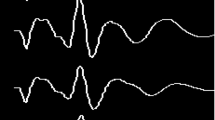Abstract
Although diagnostic testing with auditory evoked potentials (EPs) has become routine, quantitative measurements of signal and noise are still lacking. In this study, current signal, power, noise power, and signal-to-noise ratio (SNR) estimation formulas are reviewed and applied to auditory brainstem response averaging. Single-sweep responses to individual sound stimuli are recorded and estimation formulas are evaluated during off-line averaging under various sound level and noise conditions. The results show that the quality of the averaged EP can be quantitatively assessed by the continuous display of the SNR and residual noise estimates during the averaging process. This method also allows the study of different types of averaging techniques to improve EP response acquisition.
Similar content being viewed by others
References
Aunon, J. I., C. D. McGillem, and D. G. Childers. Signal processing in evoked potential research: Averaging and modeling.CRC Crit. Rev. Bioeng. 5:323–367, 1981.
Bershad, N. J., and A. J. Rockmore. On estimating signal-to-noise ratio using the sample-correlation coefficient.IEEE Trans. Inform. Theory IT-20:112–113, 1974.
Callaway, E., and R. A. Halliday. Evoked potential variatbility: Effects of age, amplitude and methods of measurement.Electroencephalogr. Clin. Neurophysiol. 34: 125–133, 1973.
Coppola, R., R. Tabor, and M. S. Bushbaum. Signal to noise ratio and response variability measurements in single trial evoked potentials.Electroencephalogr. Clin. Neurophysiol. 44:214–222, 1978.
Davila, C., and M. S. Mobin. Weighted averaging of evoked potentials.IEEE Trans. Biomed. Eng. BME-39: 338–345, 1992.
Delgado, R. E., Ö. Özdamar, and R. E. Eilers. Rapid automated ABR threshold determination for newborn hearing screening.Audiol. Today 5:43, 1993.
Delgado, R. E., Ö. Özdamar, and E. Miskiel. On-line system for automated auditory evoked response threshold determination. In:IEEE EMBS Tenth Annual Conference Proceedings, IEEE Press, New York, NY, 1988, pp. 1472–1473.
Don, M., C. Elberling, and M. Waring. Objective detection of averaged auditory brainstem responses.Scand. Audiol. 13:219–228, 1984.
Don, M., and C. Elberling. Evaluating residual background noise in human auditory brain-stem responses.J. Acoust. Soc. Am. 96:2746–2757, 1994.
Elberling, C., and M. Don. Quality estimation of averaged auditory brainstem responses.Scand. Audiol. 13:187–197, 1984.
Elberling, C., and O. Wahlgreen. Estimation of auditory brainstem response, ABR, by means of Bayesian inference.Scand. Audiol. 14:89–96, 1985.
Elberling, C., and M. Don. Threshold characteristics of the human auditory brain stem response.J. Acoust. Soc. Am. 81:115–121, 1987.
Hoke, M., B. Ross, B. Wickesberg, and B. Lütkenhöner. Weighted averaging—theory and application to electric response auditometry.Electroencephalogr. Clin. Neurophysiol. 57:487–489, 1984.
Martin, W. H., J. W. Schwegler, A. L. Gleeson, and Y-B. Shi. New techniques of hearing assessment.Otolaryngol. Clin. North Am. 27:487–510, 1994.
Möcks, J., T. Gasser, and P. D. Tuan. Variability of single visual evoked potentials evaluated by two new statistical tests.Electroencephalogr. Clin. Neurophysiol. 57:571–580, 1984.
Özdamar, Ö., R. Delgado, R. E. Eilers, and J. E. Widen. Computer methods for automated hearing determination with auditory brainstem responses.Ear Hear. 11:417–429, 1990.
Özdamar, Ö., R. Kaplan, E. Miskiel, and R. Delgado. Human-machine interface for an interactive evoked potential electro-diagnostic system. In:Trends in Ergonomic/Human Factors IV, edited by S. Asfour. Amsterdam: North Holland, 1987, pp. 1121–1129.
Raz, J., B. Turetsky, and G. Fein. Confidence intervals for the signal-to-noise ratio when a signal embedded in noise is observed over repeated trials.IEEE Trans. Biomed. Eng. BME-35:646–649, 1988.
Sininger, Y. S. Auditory brain stem response for objective measures of hearing.Ear Hear. 14:23–30, 1993.
Turetsky, B. I., J. Raz, and G. Fein. Noise and signal power, and their effects on evoked potential estimation.Electroencephalogr. Clin. Neurophysiol. 71:310–318, 1988.
Author information
Authors and Affiliations
Rights and permissions
About this article
Cite this article
Özdamar, Ö., Delgado, R.E. Measurement of signal and noise characteristics in ongoing auditory brainstem response averaging. Ann Biomed Eng 24, 702–715 (1996). https://doi.org/10.1007/BF02684183
Received:
Revised:
Accepted:
Issue Date:
DOI: https://doi.org/10.1007/BF02684183




